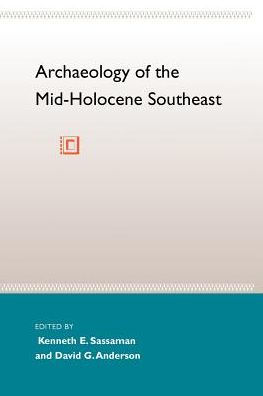"With this important volume, the editors serve notice that old characterizations of the cultures of the Archaic period have been buried under the back dirt of new excavations and new interpretations. . . . It places the Archaic cultures squarely at the forefront of archaeological theory."
This volume summarizes our archaeological knowledge of natives who inhabited the American Southeast from 8,000 to 3,000 years ago and examines evidence of many of the native cultural expressions observed by early European explorers, including long-distance exchange, plant domestication, mound building, social ranking, and warfare.
Contents
Section I. Mid-Holocene Environments
1. Geoarchaeology and the Mid-Holocene Landscape History of the Greater Southeast, by Joseph Schuldenrein
2. Mid-Holocene Forest History of Florida and the Coastal Plain of Georgia and South Carolina, by William A. Watts, Eric C. Grimm, and T. C. Hussey
Section II. Technology
3. Changing Strategies of Lithic Technological Organization, by Daniel S. Amick and Philip J. Carr
4. Technological Innovations in Economic and Social Contexts, by Kenneth E. Sassaman
5. Middle and Late Archaic Architecture, by Kenneth E. Sassaman and R. Jerald Ledbetter
Section III. Subsistence and Health
6. The Paleoethnobotanical Record for the Mid-Holocene Southeast, by Kristen J. Gremillion
7. Mid-Holocene Faunal Exploitation in the Southeastern United States, by Bonnie W. Styles and Walter E. Klippel
8. Biocultural Inquiry into Archaic Period Populations of the Southeast: Trauma and Occupational Stress, by Maria O. Smith
Section IV. Regional Settlement Variation
9. Approaches to Modeling Regional Settlement in the Archaic Period Southeast, by David G. Anderson
10. Southeastern Mid-Holocene Coastal Settlements, by Michael Russo
11. Accounting for Submerged Mid-Holocene Archaeological Sites in the Southeast: A Case Study from the Chesapeake Bay Estuary, Virginia, by Dennis B. Blanton
Section V. Regional Integration and Organization
12. The Emergence of Long-Distance Exchange Networks in the Southeastern United States, by Richard W. Jefferies
13. A Consideration of the Social Organization of the Shell Mound Archaic, by Cheryl P. Claassen
14. Southeastern Archaic Mounds, by Michael Russo
15. Poverty Point and Greater Southeastern Prehistory: The Culture That Did Not Fit, by Jon L. Gibson
Kenneth E. Sassaman is archaeologist with the Savannah River Archaeological Research Program, South Carolina Institute of Archaeology and Anthropology, and instructor in the Department of History and Anthropology at Augusta College, Augusta, Georgia. He is the author of Early Pottery in the Southeast: Tradition and Innovation in Cooking Technology. David G. Anderson is archaeologist with the Southeast Archaeological Center, National Park Service, Tallahassee, Florida. He is the author of The Savannah River Chiefdoms: Political Change in the Late Prehistoric Southeast. They are coeditors of The Paleoindian and Early Archaic Southeast.
"With this important volume, the editors serve notice that old characterizations of the cultures of the Archaic period have been buried under the back dirt of new excavations and new interpretations. . . . It places the Archaic cultures squarely at the forefront of archaeological theory."
This volume summarizes our archaeological knowledge of natives who inhabited the American Southeast from 8,000 to 3,000 years ago and examines evidence of many of the native cultural expressions observed by early European explorers, including long-distance exchange, plant domestication, mound building, social ranking, and warfare.
Contents
Section I. Mid-Holocene Environments
1. Geoarchaeology and the Mid-Holocene Landscape History of the Greater Southeast, by Joseph Schuldenrein
2. Mid-Holocene Forest History of Florida and the Coastal Plain of Georgia and South Carolina, by William A. Watts, Eric C. Grimm, and T. C. Hussey
Section II. Technology
3. Changing Strategies of Lithic Technological Organization, by Daniel S. Amick and Philip J. Carr
4. Technological Innovations in Economic and Social Contexts, by Kenneth E. Sassaman
5. Middle and Late Archaic Architecture, by Kenneth E. Sassaman and R. Jerald Ledbetter
Section III. Subsistence and Health
6. The Paleoethnobotanical Record for the Mid-Holocene Southeast, by Kristen J. Gremillion
7. Mid-Holocene Faunal Exploitation in the Southeastern United States, by Bonnie W. Styles and Walter E. Klippel
8. Biocultural Inquiry into Archaic Period Populations of the Southeast: Trauma and Occupational Stress, by Maria O. Smith
Section IV. Regional Settlement Variation
9. Approaches to Modeling Regional Settlement in the Archaic Period Southeast, by David G. Anderson
10. Southeastern Mid-Holocene Coastal Settlements, by Michael Russo
11. Accounting for Submerged Mid-Holocene Archaeological Sites in the Southeast: A Case Study from the Chesapeake Bay Estuary, Virginia, by Dennis B. Blanton
Section V. Regional Integration and Organization
12. The Emergence of Long-Distance Exchange Networks in the Southeastern United States, by Richard W. Jefferies
13. A Consideration of the Social Organization of the Shell Mound Archaic, by Cheryl P. Claassen
14. Southeastern Archaic Mounds, by Michael Russo
15. Poverty Point and Greater Southeastern Prehistory: The Culture That Did Not Fit, by Jon L. Gibson
Kenneth E. Sassaman is archaeologist with the Savannah River Archaeological Research Program, South Carolina Institute of Archaeology and Anthropology, and instructor in the Department of History and Anthropology at Augusta College, Augusta, Georgia. He is the author of Early Pottery in the Southeast: Tradition and Innovation in Cooking Technology. David G. Anderson is archaeologist with the Southeast Archaeological Center, National Park Service, Tallahassee, Florida. He is the author of The Savannah River Chiefdoms: Political Change in the Late Prehistoric Southeast. They are coeditors of The Paleoindian and Early Archaic Southeast.

Archaeology of the Mid-Holocene Southeast
416
Archaeology of the Mid-Holocene Southeast
416Paperback

Product Details
| ISBN-13: | 9780813018553 |
|---|---|
| Publisher: | University Press of Florida |
| Publication date: | 10/16/1996 |
| Series: | Florida Museum of Natural History: Ripley P. Bullen Series |
| Pages: | 416 |
| Product dimensions: | 5.90(w) x 8.90(h) x 1.10(d) |
| Lexile: | 1450L (what's this?) |
